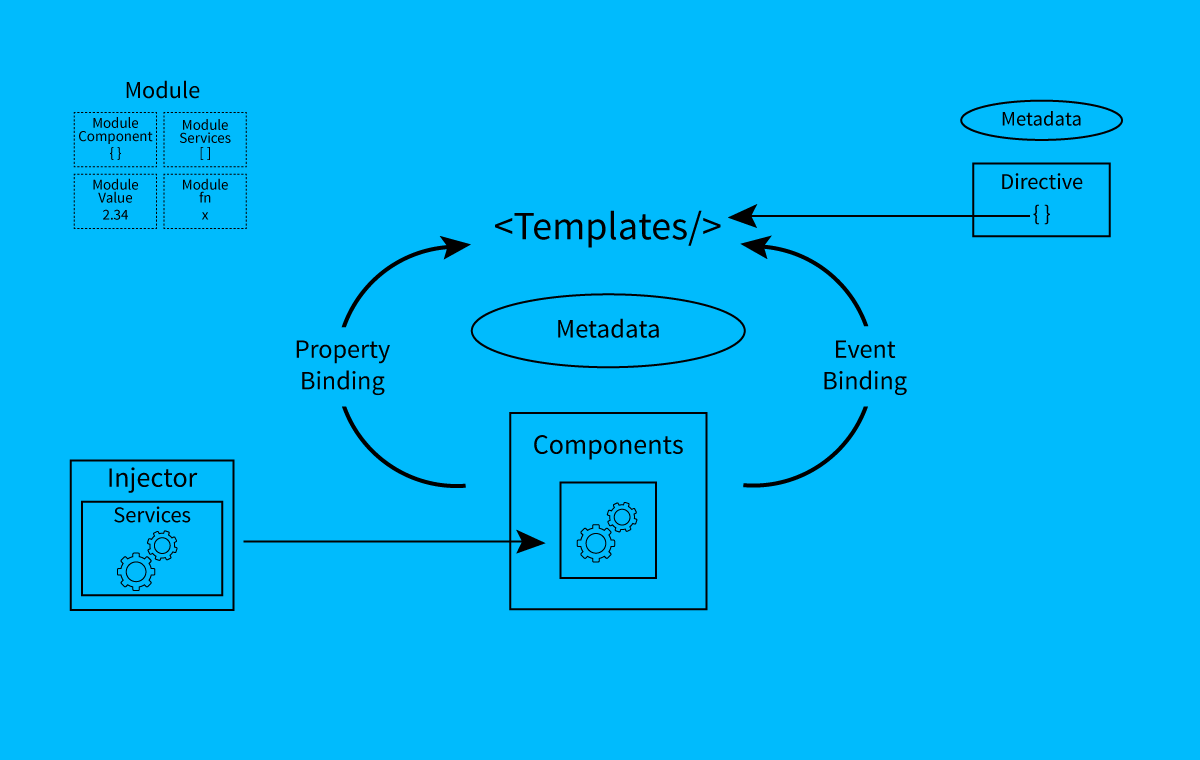- Modules
- Components
- Templates
- Metadata
- Data binding
- Directives
- Services
- Dependency Injection
Let's go over each one of them one by one.
Modules
Modules are blocks of code that do a certain type of task. A
module exports some value in the main code, such as class. The first and
the most common module that you will study is the one that exports Component Class.
app/app.component.ts (excerpt)
Here app.component is a module.
Libraries
Libraries' names start with the @angular prefix. Modules can be a library of other modules. Angular 2 itself has many modules that are libraries of others.
@angular/core is the most important library that contains most of the modules that we need.
Components
A component is basically a class that is used to show an
element on the screen. The components have some properties and by using
them we can manipulate how the element should look and behave on the
screen. We can create a component, destroy, and update as the user moves
in the application. Life Cycle hooks are the modules that we use for
this purpose. Like ngOnInit()
app/app.component.ts (excerpt)
Here blogComponent is a component.
Templates
The view of the component is defined through templates. Templates are basically the HTML we use to show on our page.
app/hero-list.component.html
This is a simple HTML file, but you may wonder: What are these elements?
*ngFor,{{food.name}}, (click), [food], and ?
Metadata
Metadata tells Angular how a class should be processed on the screen. For example:
To tell Angular that we are using a component with certain metadata, we attach a decorator to it (“@”).
Here @Component will be identified as a component class.
Selector tells Angular to render the HTML that templateURL has at this tag
Directives are other components that this Component will require to render and providers are the services required.
The template, metadata, and component together describe a view.
Data Binding
The main feature of any JavaScript framework is data binding. As Angular 1, Angular 2 also support data binding.
There are 4 ways of binding a data according to the direction to the DOM, from the DOM, or in both directions:
- The {{hero.name}} interpolation display food.name value in li tag.
- The [hero] property binding passes the selected food value from parent to child component.
- The (click) event binding calls the selectedFood function when a user clicks on it.
- Two-way data binding is an important fourth way that combines property and event binding by the ngModel directive.
Directive
Directive helps us to add behavior to the DOM elements. We
can attach multiple directives to the DOM elements. In TypeScript we
define decoratives by @decorative decorator.
There are 3 types of decorative:
- Directive-with-a-template
- Structural
- Attribute
A component is a directive-with-a-template:
Structural directives add, delete and replace DOM elements. For example:
<food-detail *ngIf="selectedFood"></food-detail>
Attribute directives change the appearance of DOM elements. For example:
Services
A service is a class containing any function, feature with a defined, and specific purpose. For example:
Dependency Injections
Dependency injection allows one to inject a dependency as a
service throughout the web application. To inject a dependency we do not
create a service but we have a constructor to request the service. The
framework then provides it. For example:
constructor(private service: HeroService) { }













